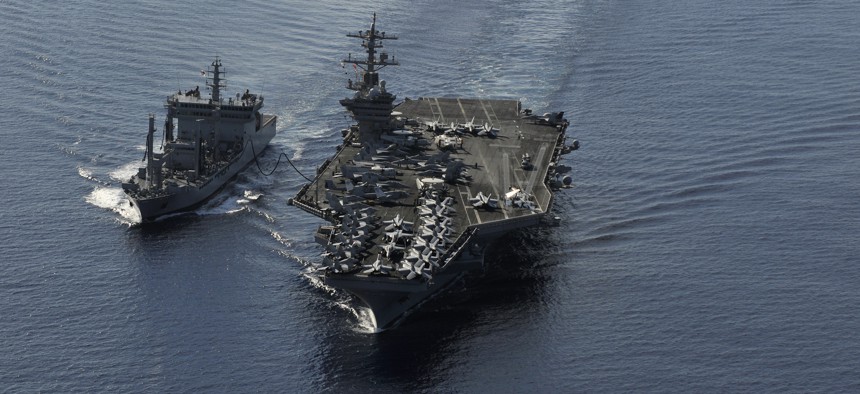
The Nimitz-class aircraft carrier USS Carl Vinson (CVN 70) and the Indian navy replenishment oiler INS Shakti (A57) conduct a refueling at sea exercise, April 13, 2012. U.S. Navy photo by Mass Communication Specialist Apprentice Andrew K. Haller
US, Indian Navies Planning Joint Patrols in South China Sea
Officials say they're drafting ideas one year after leaders agreed to expand naval cooperation and ensure freedom of navigation in the SCS.
The already hot waters of the South China Sea seem to be heading for boiling point.
The US and India have held talks to conduct joint naval patrols in the Indian Ocean and in the South China Sea by the end of the year, Reuters reported. Joint naval patrols involve two countries working together to secure maritime interests, a manoeuvre that the Indian Navy has so far never undertaken.
A strategically vital and reportedly oil rich 3,500,000-square-kilometre body of water, the South China Sea is ensconced between the Asian mainland and a whole host of east Asian island nations. And almost every country touched by it—China, The Philippines, Vietnam, Indonesia, Brunei, and Malaysia, among others—claim some right or the other over it, or at least over some part of it.
China, of course, is the most assertive. The dominant military and economic power in the region, Beijing has been building man-made islands to use as bases for supporting air and sea patrols. The idea is also perceived to be part of its strategy to legitimise its claims over the region in the long run.
India’s apparent decision to partner Washington in patrolling the region comes a year after US president Barack Obama and Indian prime minister Narendra Modi agreed to “identify specific areas for expanding maritime cooperation” and “ensuring freedom of navigation” in the South China Sea. When they met in New Delhi in January 2015, the two leaders had expressed concerns about “rising tensions over maritime territorial disputes” in the region.
An emailed questionnaire to India’s foreign ministry by Quartz remained unanswered while an Indian Navy spokesperson said he wasn’t aware of any decision on the joint patrolling. A Pentagon spokesperson, meanwhile, said that “on the matter of joint patrols, no decisions have been made and we do not have any additional details to provide at this time.”
See also: Defiant Chinese Admiral’s Message: South China Sea ‘Belongs to China’ and Navy Unveils Video of Manmade Islands in South China Sea
Kanwal Sibal, a former Indian foreign secretary, expressed skepticism at possibility of the joint patrols.
“So far, India has not faced any problem with its vessel movement in the region and unless there is provocation, there is no need for India to undertake a joint patrol,” Sibal told Quartz. “The implications of such an act can be big.”
Other analysts, however, viewed the possible move as more aggressive posturing by New Delhi.
“I think India has become more candid about its foreign policy now,” Sameer Patil, a fellow at Mumbai-based think tank, Gateway House, told Quartz. “For instance, India had never put its bilateral concerns on paper, which it did when the US president visited India last year. This recent decision is sending a strong message to China.”
“This will signal to the Chinese that they cannot undermine us (India) and expect us not to react,” Manoj Joshi, a distinguished fellow at the New Delhi-based think tank, Observer Research Foundation, told Quartz.
“This is a signal for a realignment of the Indian foreign policy. Till now, India said it was unaligned, it remains so today. But it has distinctly come closer to the US and Japan. This is also a signal that India does not expect too much from China, either in the settlement of the border dispute or from investments.”
Since coming to power in 2014, Modi has spent much time and effort on foreign policy. Closer home, his trips to Pakistan, Afghanistan, Bhutan, Nepal, Sri Lanka, and Myanmar, have been largely aimed at rebuilding India’s influence in the region. Modi has also actively engaged with China, hosting president Xi Jinping in September 2014 before making a trip to Beijing in May 2015.